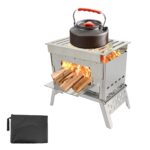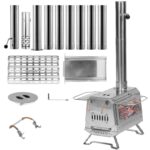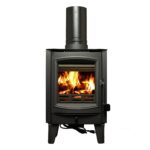
Introduction to Wood Burning Camping Stoves
Wood burning camping stoves have gained significant traction among outdoor enthusiasts seeking a reliable and eco-friendly cooking solution for their adventures. Unlike traditional fuel sources, such as propane or butane, wood burning stoves harness the power of renewable wood as fuel. This not only reduces dependence on commercially produced fuels but also aligns with a growing emphasis on sustainability and environmental stewardship in outdoor activities.
One of the primary advantages of wood burning camping stoves is their capability to operate independently of fossil fuels. Campers can simply gather fallen twigs, branches, and other natural materials found in their surroundings, which significantly lessens the need to carry bulky fuel canisters. This factor is particularly appealing for individuals looking to minimize their pack weight during hikes or long camping trips. Additionally, the use of locally sourced wood helps lower the carbon footprint often associated with traveling and camping.
Moreover, wood burning stoves offer superior cooking versatility and efficiency, enabling campers to prepare a diverse range of meals. The heat produced by wood fires can be easily adjusted, allowing for high temperatures for boiling water or lower temperatures for simmering meals. Traditional fuel stoves often provide limited flexibility in heat control, which can restrict cooking options in the wilderness.
In terms of environmental impact, wood burning camping stoves contribute to a smaller ecological footprint by utilizing a renewable resource. By opting for wood as fuel, campers can promote responsible forest management and ensure that the natural environment remains intact for future generations. As awareness about the importance of sustainable practices continues to rise, many outdoor enthusiasts are embracing wood burning camping stoves, leading to a shift towards greener and more responsible camping experiences.
Types of Wood Burning Camping Stoves
Wood burning camping stoves have gained popularity due to their efficiency and minimal environmental impact. Various types of camping stoves cater to different needs, preferences, and camping scenarios. Understanding these types can aid campers in selecting the most suitable option for their outdoor activities.
One prominent category is the portable folding stove. These stoves are designed for ease of transport and setup, making them ideal for campers who prioritize mobility. Typically constructed from lightweight materials such as stainless steel or aluminum, portable folding stoves collapse into a compact size, facilitating storage in backpacks. Despite their small footprint, many of these models provide impressive heat output and cooking capabilities, suitable for boiling water or preparing simple meals while on the trail.
Stationary wood burning camping stoves represent another type, often favored for extended stays at designated campsites. These stoves are more robust and typically require a more permanent setup. Some models may even include a chimney, enabling improved ventilation and reducing smoke in the cooking area. Equipped to handle larger cooking vessels and heavy-duty tasks, stationary models are excellent for group camping or family outings where the stove serves as a central cooking point.
Lastly, multi-fuel stoves add versatility to the wood burning camping stove category. As the name suggests, these stoves can operate on various fuel types, including wood, charcoal, or even propane. This flexibility is advantageous for campers who may have limited access to specific fuel sources. Multi-fuel stoves are often designed with adjustable air controls and efficient combustion systems, enhancing their performance across different fuels and ensuring efficient heat generation regardless of the chosen method.
How to Choose the Right Wood Burning Stove
Selecting the appropriate wood burning camping stove requires careful consideration of various factors tailored to your specific camping style. First and foremost, the size of the stove is crucial; it should be compact enough for easy transport yet adequately sized to accommodate the cooking needs of all campers. A stove with a smaller footprint is desirable for backpacking trips, while a larger one might be necessary for family camping where more meals are prepared at once.
Weight is another vital aspect to consider, especially for hikers who carry all their gear on their backs. A lightweight stove made from materials like aluminum or titanium can significantly ease the burden on your pack. For car camping scenarios, weight may be less of an issue; hence, a more robust stove made from stainless steel could be appropriate, providing durability and longevity.
The material used in the construction of the wood burning stove affects not only its weight but also its heat retention and cooking efficiency. Stainless steel and cast iron are excellent choices, known for their ability to distribute heat evenly, while aluminum is lighter but may not insulate as well.
When assessing heat output, examine the stove’s design and airflow capabilities. A versatile model that allows for adjustable airflow can help fine-tune the heat for different cooking needs, from boiling water to roasting. Ease of use cannot be overlooked; look for features such as a simple assembly process, user-friendly controls, and the ability to easily feed in wood or other combustible materials.
Ultimately, the ideal wood burning camping stove aligns with your cooking style, frequency of use, and environmental adaptability. By evaluating these crucial elements, you’ll be well on your way to choosing a stove that meets your camping requirements.
Setting Up Your Wood Burning Stove
When embarking on a camping trip with a wood burning stove, one of the pivotal steps is setting up the stove safely and effectively. The initial consideration involves selecting an appropriate location. Opt for a flat, stable ground, ideally at least 10 feet away from your tent, vegetation, and other combustible materials. This distance minimizes the risk of unexpected fire hazards. Additionally, check weather conditions—avoid windy sites that could carry sparks away from the stove.
Once the ideal location is identified, the next step is to prepare your wood burning stove for operation. It is essential to inspect the stove for any damages or debris before use. Make sure all components are in place and functioning properly to prevent issues during cooking. For optimal performance, only use seasoned wood; this type of wood burns more efficiently and produces less smoke. Have a well-established fire pit or heat-resistant surface to place the stove on, further limiting fire risks.
Compliance with local fire regulations is paramount. Before setting up, research the camping area’s specific regulations concerning wood burning stoves. Some regions may require permits, while others might have designated sites for cooking. Understanding these rules not only ensures your safety but also protects the natural environment. When lighting the fire, always have a bucket of water or a fire extinguisher available nearby to tackle any potential issues promptly.
Finally, practicing good safety habits while using your wood burning camping stove is crucial. Never leave the stove unattended, and ensure the fire is completely extinguished before sleeping or leaving the site. By meticulously setting up your wood burning stove and adhering to safety guidelines, you can enjoy the rewards of cooking with fire while minimizing risks. Happy camping!
Best Practices for Using a Wood Burning Stove
When utilizing a wood burning camping stove, adhering to best practices can enhance the cooking experience and extend the lifespan of the stove. First and foremost, the choice of wood is crucial. Selecting dry, seasoned hardwood, such as oak, maple, or hickory, yields cleaner burns and better heat output. Avoid using softwoods, as they may produce excessive smoke and creosote that can accumulate in the stove, leading to inefficiencies.
Starting a fire in a wood burning stove involves creating a conducive environment for combustion. Begin by placing small, dry kindling at the base of the stove, structured in a teepee or crisscross pattern for optimal airflow. Gradually add larger pieces of wood as the kindling ignites and the flames establish themselves. It is advisable to avoid using accelerants, as they can create harmful vapors and undermine the overall safety of the operation.
Once the fire is established, maintaining heat control becomes essential for effective cooking. This can be achieved by adjusting the air vents on the stove to regulate airflow, which in turn controls the burn rate of the wood. If the fire burns too hot, closing the vents slightly can help moderate the temperature. Conversely, if more heat is required for cooking, opening the vents can increase the burn intensity. Monitoring the stove regularly ensures that the temperature remains stable, allowing for even cooking.
Lastly, keeping the wood burning stove clean makes a significant difference in its performance and longevity. Regularly ash removal after each use prevents overloading, which can inhibit airflow and combustion. Inspect the flue and chimney periodically to avoid blockages caused by creosote buildup. By following these best practices, campers can effectively utilize their wood burning camping stoves for delightful outdoor culinary experiences while ensuring safety and efficiency.
Cleaning and Maintaining Your Wood Burning Stove
Proper cleaning and maintenance of your wood burning camping stove are essential for ensuring longevity and optimal performance. An efficiently functioning stove not only enhances your cooking experience but also ensures safety, reducing the risk of fire hazards associated with soot buildup and ash accumulation.
After each use, allow the stove to cool down completely before starting the cleaning process. Begin by carefully removing the ashes from the stove. This can be achieved by using an ash shovel or a small scoop. Dispose of the ashes properly, ideally in a metal container away from flammable materials. Regular ash disposal is crucial as leftover ash can impede airflow, affecting combustion and heating efficiency.
For soot removal, it is advisable to inspect the flue and chimney areas. If you notice any blockage, use a chimney brush to clean these components. This task should be performed at least once per season to prevent buildup that could lead to dangerous chimney fires. Additionally, inspecting the chimney cap and ensuring it is free from debris will promote unobstructed airflow.
Routine upkeep tasks, such as checking the seals and gaskets of the stove, are vital in maintaining an airtight environment for improved combustion. Damaged seals should be replaced promptly to ensure that your stove operates at maximum efficiency. Furthermore, regularly examining the interior walls of the stove for cracks or warping is essential, as these issues can compromise overall performance.
Lastly, consider applying a high-heat protective finish to the exterior of the stove periodically to safeguard against rust or corrosion. By adhering to these cleaning and maintenance practices, you can ensure your wood burning camping stove remains in prime operating condition for many adventures to come.
Safety Tips for Using Wood Burning Camping Stoves
Utilizing wood burning camping stoves can enrich outdoor experiences, offering warmth and cooking capabilities in nature. However, it is crucial to prioritize safety while using these devices to prevent accidents and ensure a responsible relationship with the environment. Follow these guidelines to enhance your safety and the safety of those around you.
Firstly, always position the stove on a stable, level surface, away from flammable materials such as dry leaves, branches, or tents. This setup minimizes the risk of unintentional fires. It’s also advisable to choose a location that is shielded from strong winds, as gusts can easily cause flames to spread or embers to blow onto combustible materials.
Secondly, managing smoke is vital for a safe experience. Be aware of wind direction and adjust the stove accordingly to minimize smoke inhalation. Ensure that the wood used is dry and seasoned, as green or wet wood produces more smoke and can be hazardous to health.
To handle the stove safely, always use heat-resistant gloves when touching the stove or cooking equipment, as surfaces can become extremely hot. Additionally, refrain from leaving the stove unattended while in operation. Keep a close watch, particularly when children or pets are nearby, as they might not understand the dangers associated with hot surfaces.
When you have finished using the stove, ensure that all ashes and embers are completely extinguished before leaving the site. Not only does this practice prevent potential fires, but it also demonstrates environmental stewardship, promoting a responsible camping culture. Bringing a proper extinguishing method such as water or sand can enhance safety when it comes to cooling off the stove.
By following these essential safety tips, users can enjoy the benefits of wood burning camping stoves while mitigating risks, ensuring a pleasurable and secure camping experience. Being responsible is key to preserving nature and maintaining a safe environment for all.
Top Wood Burning Camping Stoves in 2023
In 2023, a variety of wood burning camping stoves are available, each designed to enhance outdoor cooking experiences. Among the top contenders is the BioLite CampStove 2+. This innovative stove not only allows for efficient wood burning but also generates electricity to charge devices via a USB port. It features a built-in fan, which aids combustion and promotes efficient heat output. Users appreciate its portability and the convenience it offers for both cooking and charging small electronics. However, the price point may be a consideration for budget-conscious campers, as it is higher than traditional models.
Another notable option is the Stansport Heavy Duty 5-Panel Tent Stove. This sturdy stove is perfect for larger tents or basecamps, featuring a durable construction designed to handle heavy use. Its large size allows it to burn wood effectively, providing ample heat. However, its weight may deter backpackers, as it is less portable compared to other stoves. The stove comes with a chimney pipe that enhances airflow and directs smoke outside, making it safe for indoor use in the right conditions.
The Solo Stove Lite is a minimalist choice renowned for its efficiency and compact size. Constructed from stainless steel, this lightweight option is ideal for solo hikers and minimalists. The double-wall design enhances combustion efficiency, ensuring a clean burn that minimizes smoke. Although users find its performance excellent for cooking meals, its small cooking surface means it may not be suitable for larger groups or specific cooking requirements.
Finally, the OUTWELL Fire Pit deserves mention for its versatility as both a fire pit and a cooking stove. This model’s unique design allows for various cooking methods, making it a popular choice for campfire cooking enthusiasts. While it is highly praised for its multifunctionality, some users note the need for additional accessories to optimize efficiency.
Conclusion: The Future of Outdoor Cooking
As outdoor cooking continues to evolve, wood burning camping stoves stand out as a sustainable and efficient choice for campers and outdoor enthusiasts. These stoves not only offer a practical solution for cooking meals in remote locations, but they also promote an environmentally friendly approach to food preparation. Utilizing readily available natural resources, such as twigs and small branches, wood burning stoves significantly reduce reliance on fossil fuels and disposable gas canisters. This crucial characteristic aligns perfectly with the growing emphasis on sustainability in camping and outdoor recreation.
The benefits of wood burning camping stoves extend beyond eco-friendliness. They provide campers with a unique cooking experience, enhancing the enjoyment of preparing meals in nature. The authentic flavor imparted by the wood fire can transform a simple meal into a memorable feast, allowing individuals to connect with their surroundings in a deeper way. Moreover, wood burning camping stoves are often more versatile than their propane counterparts, allowing users to boil water, sauté, or simmer dishes effectively, making them a valuable addition to any camping gear collection.
As the outdoor community increasingly seeks sustainable alternatives, the wood burning camping stove is likely to gain traction. Innovative designs and technologies are being developed to enhance efficiency and ease of use, suggesting that this trend will continue to grow. By adopting wood burning stoves, campers not only enjoy the immediate benefits of their functionality but also contribute positively to environmental conservation efforts. The future of outdoor cooking is moving towards a more sustainable paradigm, and integrating wood burning stoves into camping practices can significantly impact our ecological footprint.





